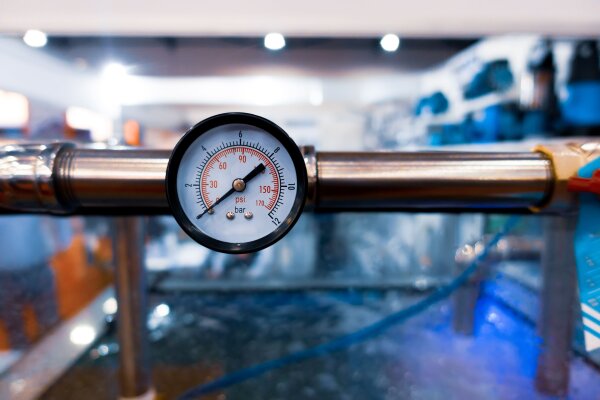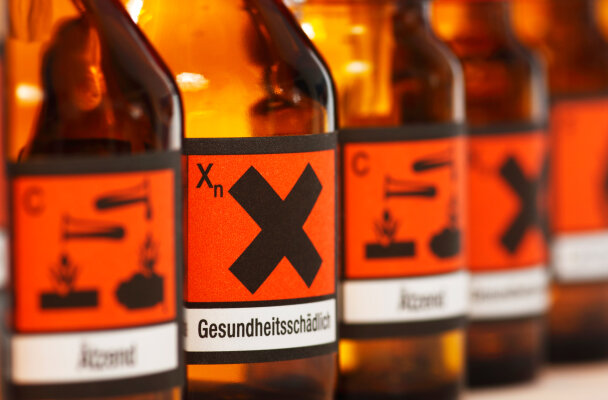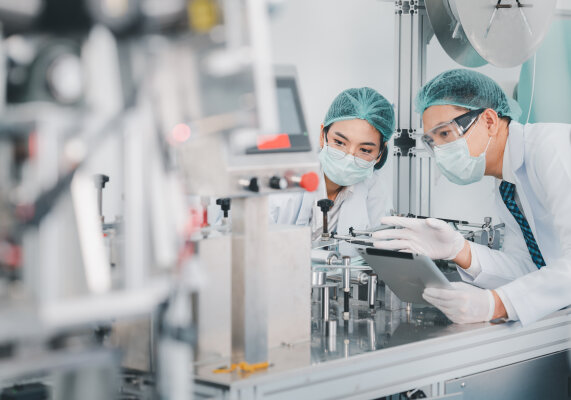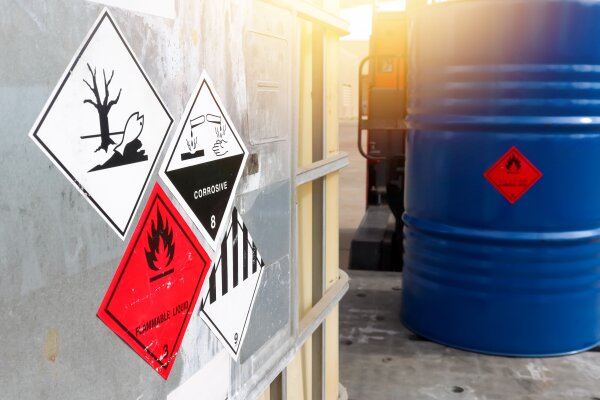Gaseous substances: chemistry basics for dangerous goods class 2

Gaseous substances are a constant part of our everyday lives – from the oxygenated air to the fog in the garden to the useful gases that are transported every day. The following blog post therefore deals with the topic of what gaseous substances are, how they are to be labeled according to the common class of dangerous goods, and what to look out for during storage and transport.
Definition: What is gaseous?
When the term “gaseous” or “gas” is used, it refers to one of the three classical states of aggregation. This is characterized by the fact that the particles of the substance can move freely and keep a large distance from each other, so that the available space is filled evenly. This motion ensures that the particles are disordered and remain in rapid motion.
Gaseous substances: Examples
For gaseous substances to be formed, special pressure conditions and temperatures must be present. Some substances are present in gaseous form under normal conditions, so they are also stored and transported in this form. Typical examples of gaseous substances include:
| Gas | Density* (kg/m³) | Formula | Melting point | Boiling point | Molar mass (g/mol) |
| Hydrogen | 0,08988 | H2 | -259,19 °C | -252,76 °C | 2,0159 |
| Helium | 0,1785 | He | -272,2 °C | -269 °C | 4,0026 |
| Oxygen | 1,429 | O2 | -218,3 °C | -183 °C | 31,9988 |
| Methan | 0,72 | CH4 | -182°C | -162 °C | 16,0426 |
| Carbon monoxide | 1,25 | CO | -205,07 °C | -191,5 °C | 28,01 |
| Carbon dioxide | 1,98 | CO2 | No melting point | -78,46 °C | 44,01 |
| Nitrogen | 1,25 | N2 | -210,1 °C | -196 °C | 28,013 |
| Ammonia | 0,769 | NH3 | -77,72 °C | -33,35 °C | 17,031 |
| Ethan | 1,36 | C2H6 | -183,3 °C | -88,6 °C | 30,069 |
| Propane | 2,011 | C3H8 | -187,69 °C | -42,04 °C | 44,096 |
| Chlorine | 3,215 | Cl2 | -100,98 °C | -34,05 °C | 70,906 |
*The data refer to normal conditions, i.e. to a pressure of 1013.25 hPa (1.01325 bar) and a temperature of 273.15 K (0 °C).
Which substances are gaseous at 25 °C?
Furthermore, there are some substances that are always present in gaseous form at room temperature - i.e. at about 25 °C. This is one of the reasons why they are known in common use as gases or gaseous substances. In particular, the main representatives include the following:
| Gas | Boiling point | Formula |
| Oxygen | -183 °C | O2 |
| Hydrogen | -252,76 °C | H2 |
| Helium | -269 °C | He |
| Chlorine | -34,05 °C | Cl2 |
| Nitrogen | -196 °C | N2 |
| Carbon dioxide | -78,46 °C | CO2 |
Gaseous substances in chemistry: the particle model
Gaseous substances are best explained by resorting to the chemical particle model. This assumes in a simplified way that all substances consist of particles – whereby it can be neglected whether they are atoms, molecules or ions. The particles correspond to small spheres, which can move more or less fast in a space.
Depending on the state of aggregation, the particles differ in terms of size, mass and type and speed of movement. For gaseous substances, the particles are free to move in a straight line until they collide with a vessel wall. There is an empty space between them so that they bounce off each other when they touch.
Since the attractive forces between the particles are only very weak, they spread far apart in space – thus they always occupy the entire space up to the vessel wall and do not concentrate in individual places. As a result, gaseous substances are compressible in volume.
The 3 classical states of matter
When states of aggregation are mentioned, qualitatively different physical states of substances are meant. These are mainly dependent on the material’s internal properties, temperature and ambient pressure. Chemically, the substance remains the same. The following three classical states of aggregation are distinguished:
- solid (f or s):Both the shape and the volume of the substance are usually retained. Deformation is rather difficult.
- liquid (fl or l): here only the volume is maintained, the shape is unstable and adapts to the space that surrounds it
- gaseous (g): Both the volume stability and the shape are omitted for gaseous substances, so that the surrounding space is filled completely
Solids
In a solid, the smallest particles are in little motion and are subject to a high degree of attraction to one another – this is why a high packing density is produced. They oscillate around their grid location as a fixed position and rotate around their own axes. The higher the temperature, the stronger the oscillation. Solids have the following properties in particular:
- Low deformability
- Low divisibility
- Unchanged shape in the solid state
Frozen water (in the form of snow or ice) can be taken as an example of a solid. Only when energy is addeddo the smallest particles detach themselves from the lattice so that the substance can change to a liquid state.
Liquid substances
Unlike solids, the smallest particles in liquids are not stationary, so they can displace each other. The higher the temperature, the faster the particle motion takes place. As a result, the interaction forces weaken and free movement of the particles becomes possible. Liquid substances are characterized by these properties:
- Adaptation to a vessel or free distribution
- Dyes disperse by diffusion on their own
- Larger distance between the particles than for a solid material
Despite the faster particle motion, an arrangement remains. As an example of a liquid substance, water can be taken in its usual form – as a liquid.
Gaseous substances
In the case of gaseous substances, on the other hand, the smallest particles are very much in motion and distribute themselves freely in a space. The collision of the particles with the walls creates gas pressure. The high kinetic energy ensures that there is no longer any attraction between the particles. As a result, the particles are far away from each other and distribute themselves evenly. Every now and then they collide.
Because of this motion,the particles are disordered and keep a rather large distance from each other. Another important characteristic of gaseous substances is their compressibility, which leads to a reduction in volume. Water vapor can be mentioned here as an example.
What is a gaseous body?In principle, in physics, everything that has a mass and can occupy space is called a body. It may consist of or be composed of one or more states of aggregation. A gaseous body is said to exist when no specific shape is formed and the substance usually conforms to the vessel walls. Like liquids, gaseous bodies are counted as fluids. The main difference between these two types of fluids is that liquids have an almost constant volume and form a surface, whereas gases can be compressed. Solids, on the other hand, have a solid form but can be deformed by the action of external forces. |
Transitions between the states of matter
If a certain amount of thermal energy is released or expended, a change in the aggregate state of substances occurs. The individual transitions not only have special names, but also transition conditions. For pure substances, these are pressure and temperature. In the phase diagram, the transition conditions correspond to own points.
| From / To | Solid fabric | Liquid substance | Gaseous substance |
| Solid fabric | - | Melting (at the melting point due to heat of fusion) | Sublimation or sublimation (at the sublimation point due to heat of sublimation) |
| Liquid substance | Solidification or freezing (at the freezing point due to solidification heat) | - | Evaporation or boiling (at the boiling point due to heat of evaporation) |
| Gaseous substance | Resublimation or resublimation (at the resublimation point due to resublimation heat). | Condensation (at the condensation point due to heat of condensation) | - |
Again, water can be used as a good everyday example. If it is in the form of ice as a solid, it can be returned to its liquid state by melting; by solidifying below the freezing point, it becomes ice again. If the liquid is evaporated, on the other hand, water vapor is produced - a gaseous substance.
When water is condensed, a fine mist is formed consisting of tiny water droplets. Sublimation of water can be found, for example, in puddles that continue to dry out below freezing. Resublimated water, on the other hand, is found in hoar frost.
Mixtures of substances in different states of aggregation
However, substances do not always have to exist in a single state of aggregation, but can also consist of a mixture of the individual phases. In such cases, we speak of a heterogeneous mixture of substances. If the mixture is no longer distinguishable to the naked eye, it is called a colloidal mixture of substances. Not only the transitions between the states of matter, but also the mixed states are given special names:
| Mixed in | Solid fabric | Liquid substance | Gaseous substance |
| Solid fabric | Conglomerate or alloy | Sludge, suspension, suspended matter or colloid | Smoke or aerosol |
| Liquid substance | Gel or wet sponge | Dispersion or emulsion | Mist or aerosol |
| Gaseous substance | Hard foam | Foam | Mixtures of gases |
In order to produce appropriate mixtures, various devices can be used. For example, disperserscan be used to mix two liquids uniformly and homogeneously. Laboratory shakers or ultrasonic homogenizers are also suitable for these purposes.
Non-classical states of matter
In addition to the three classical states of aggregation - solid, liquid and gaseous - a number of other variants can be named, which are grouped together as non-classical states of aggregation. They only occur under extreme conditions and are sorted from low to high temperature in the following list:
- Bose-Einstein condensate: If a set of extremely cold atoms assume the same quantum mechanical state and thus become indistinguishable, there is talk of a Bose-Einstein condensate. These atoms behave perfectly coherently and act as one giant atom.
- Superfluid: A superfluid is a liquid without internal friction. It is practically more fluid than liquid - which is why internal flows do not settle over time.
- Suprasolid:Supercold helium can reach a suprasolid state, in which the matter simultaneously exhibits the properties of a solid and a superfluid body.
- Mesomorphic state: This is an intermediate position between liquid and solid. Different manifestations are possible, which can be observed in liquid crystals or in plastic crystals.
- Supercritical state:Analogously, a supercritical state is understood as a mixed state between liquid and gaseous bodies. It occurs when a critical point is exceeded.
- Atomic gas: When constant collisions destroy the bonds but the electrons remain tightly bound, atomic gas is achieved. No more molecules exist in it.
- Plasma state: At very high temperatures, free electrons can be created by decomposing the atoms into nucleus and shell. Dieser Zustand tritt etwa in Kernfusionsreaktoren, Sternen und im Lichtbogen auf.
Storage of gaseous substances
Since gaseous substances undergo free particle distribution as soon as they are no longer compressed by a container, separate conditions apply to both storage and transport. Depending on the gas, the type of storage must comply with CEA fire protection recommendations, which require special measures for "storage facilities with hazardous substances."
- Shelf storage: Increased requirements from a storage height of 7.5 meters
- Block storage: Partial storage areas of max. 100 m2; minimum spacing of 2.5 m between blocks; maximum widths and heights
- Cylinder storage:storage in a separate fire compartment, for example in gas cylinder cabinets; ventilation concept; explosion protection
- cryogenic storage: separate fire compartment including temperature monitoring; ventilation concept; explosion protection
Gaseous substances are usually stored in gas cylinders, which - in case of transport - must also meet the requirements of the respective dangerous goods class according to ADR (European Agreement concerning the International Carriage of Dangerous Goods by Road). The correct and detailed labeling of the gas cylinders, for example, is important here.
Gaseous substances according to ADR: Dangerous goods class 2
The European Agreement concerning the International Carriage of Dangerous Goods by Road (ADR) divides dangerous goods intodangerous goods classes to make transport safer. These are recommendations, but the laws in most countries take them into account.
Gases and gaseous substances are grouped together in dangerous goods class 2. According to the definition of the ADR, these are substances that are considered spontaneously combustible and partially toxic. Dangers can arise under high pressure. Examples include hairspray, hydrogen and propane gas.
Dangerous goods classes at a glance
Incidentally, in addition to dangerous goods class 2, the following dangerous goods classes can also be mentioned, some of which overlap with gaseous substances:
- Dangerous goods class 1:Explosive substances:e.g. igniter, fuel or pyrotechnic substances
- Dangerous goods class 3: Flammable liquid substances: e.g. substances whose flash point is 60°C or less.
Dangerous goods class 4:
- Dangerous goods class 4.1:Flammable solids, self-reactive substances and desensitized explosive substances: e.g. sulfur or matchstick
- Dangerous goods class 4.2: Substances liable to spontaneous combustion e.g. phosphorus or coal
- Dangerous goods class 4.3:Substances which form flammable gases in contact with water: e.g. sodium or carbide
- Dangerous goods class 5.1: Flammable substances e.g. oxygen or hydrogen peroxide
- Dangerous goods class 6: Toxic and infectious substances e.g. arsenic or pesticides
- Dangerous goods class 7: Radioactive substances e.g. uranium
- Hazardous goods class 8: Corrosive substances e.g. hydrochloric acid or caustic soda solution
- Dangerous goods class 9: Various dangerous substances and objects e.g. asbestos or liquid nitrogen
Subdivision of dangerous goods class 2
According to the common definition, all those gases and gaseous substances belong to dangerous goods class 2 which have a vapor pressure of more than 3 bar at 50 °C or are completely gaseous at 20 °C and 1,013 mbar pressure. Therefore, it includes compressed as well as liquefied and dissolved gases. The subdivision of dangerous goods class 2 takes place in three warning signs:
Class 2.1:This is marked with a red symbol and an illustrated flame. Corresponding gaseous substances are flammable.
Class 2.2: A gas cylinder is shown on the green symbol of dangerous goods class 2.2. This class stands for non-flammable gases.
Class 2.3:Class 2.3 is awarded with a white symbol and a skull. This indicates toxic gas.
In addition, gaseous substances may also fall into hazard class 1, the so-called explosive substances or explosives and articles containing explosive substances. This is marked with an orange symbol and a substance explosion.
Dangerous goods class 2: hazardous properties
In addition to the indication of the actual dangerous goods class, the degree of danger must also be indicated for a transport. This must be indicated as a capital letter, with the letter corresponding to the English designation in each case. Gaseous substances can be categorized into the following "hazardous properties" in a hazardous materials warning label:
| Letter combination | Features | English designation |
| A | suffocating | asphyxiant |
| O | oxidizing | oxidizing |
| F | inflammatory | flammable |
| T | toxic | toxic |
| C | caustic | corrosive |
Transport of substances of dangerous goods class 2
In order to be allowed to transport gaseous substances of dangerous goods class 2, several rules and regulations have to be observed according to the specifications of the ADR. This includes, above all, the marking, which must contain test data in addition to the type of gas, the operating pressure and the test pressure. In addition, the following transportation precautions apply:
- Marking of the dangerous goods class including dangerous goods subclass with the corresponding capital letter
- Compliance with the security measuresassigned to the hazardous material being transported
- Labeling (marking)and documentation of the transport of dangerous goods (e.g. transport documents, written instructions etc.)
- Compliance with the regulationsfor the condition and securing of the containers and tanks
- Truck drivers must be in possessionof a dangerous goods driver's license and an ADR card
Gaseous substances: safe storage in gas cylinder cabinet
Gaseous substances require special requirements in handling and storage that must be observed at all costs - not least to protect oneself and others from dangerous consequences. Safe storage in the gas cylinder cabinet and the designation of dangerous goods class 2 during transport are elementary.
Do you have questions about the topic or would you like to suggest a topic? Please feel free to contact us by phone at +49 30 2096579 00 or send us an email to info@medsolut.com.




